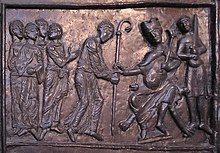Gnesen bronze door

The Gniezno bronze door is a Romanesque door in the south portal of the Arch-Cathedral in Gniezno ( Gniezno ). It dates from the period between 1160 and 1180. The two-winged door (Porta Enea, Porta Regia) depicts the martyrdom of Wojciech (Adalbart), Poland's first saint , in 18 reliefs .
description
The left wing consists of a single bronze gunmetal part and measures 328 × 84 × 1.5 centimeters. The right wing is almost the same size, but was cast in 24 individual parts and only then put together. The molds are not preserved. After installation, the door was used almost exclusively for display purposes. It was only opened for coronations and major religious holidays.
The 18 pictures thematically follow the legends about the life of Adalbert, especially the vita of Johannes Canaparius . They are evenly distributed on both door leaves. The cycle begins at the bottom left and runs from bottom to top on the left wing and from top to bottom on the right wing. The cycle is divided into groups of three.
The first three pictures on the left represent Adalbert's youth: his birth (I.), the healing of the sick boy on the altar of the church in Libice ( Libitz ) (II.) And the arrival at the cathedral school in Magdeburg (III.) . Three scenes from his work as Bishop of Prague follow: a prayer at the tomb of the martyrs (IV.), Investiture by Otto II in Verona (V) and the healing of a man possessed (VI). The top three pictures on the left show Adalbert's turning away from the world: a dream in which Christ appears to the bishop (VII.), Liberation of Christian slaves (VIII.) And a miracle scene in the Roman monastery on the Aventine (IX).
The right page begins at the top with Adalbert's activity as a missionary. After the landing of his ship in Prussia (X.) the door shows the bishop baptizing pagans (XI.) And preaching before the hostile Prussians (XII.). In the middle is his death: the last mass (XIII.), The martyr's death (XIV.) And the laid body with the head of Adalbert (XV.) Impaled on a stake. The last three scenes describe the beginning of his cult of saints. Duke Boleslaw buys the missionary's body free (XVI.), The body is solemnly transferred to Gniezno (XVII.) And buried in the cathedral there (XVIII.).
origin
The work was commissioned by an Archbishop of Gniezno , Zdzisław I (before 1177–1180) or Bogumil (after 1180 to before 1191). The door is said to have been created by artists from the Meuse region and cast in Gniezno themselves. There are also suspicions that a connection with the cathedral of Hildesheim exists, because the scenes of the Bernward door in Hildesheim Cathedral have a similar, rare on medieval images doors arrangement. However, the sequence of images in Hildesheim is reversed: on the left side downwards and on the right upwards. A joint presentation of both works of art is also considered possible.
literature
- Adam Bujak: Porta Regia. The bronze door of Gniezno . Gniezno 1988, ISBN 83-87901-02-4 .
- Pavol Černý: The Life of St. Adalbert of Prague on the bronze door of Gniezno . In: A thousand years of Benedictines in the monasteries of Břevnov, Braunau and Rohr . EOS Verlag, Archabbey St. Ottilien 1993, ISSN 0303-4224 .
- Wilfried Gerke , Elfriede Henke: Germans in the Gnesener Land. Former districts of Gniezno and Witkowo . Home district community Gnesen, Hanover 1981.
- Adolph Goldschmidt: The bronze doors of Novgorod and Gniezno . University / Art History Seminar, Marburg 1932 (The early medieval bronze doors; 2).
- Petr Sommer, Jiří Sláma: Bronzové dveře hnězdenského dómu . In: Petr Sommer, Dušan Třeštík, Josef Žemlička u. a .: Přemyslovci. Budování českého státu . Nakladatelství Lidové noviny, Prague 2009, ISBN 978-80-7106-352-0 , pp. 246-250.

